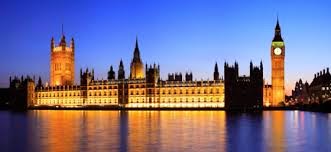Tower
Bridge (built 1886–1894) is a combined bascule and
suspension bridge in London, England which crosses the River Thames.
It is close to the Tower of London, from which it takes its name,
and has become an iconic symbol of London.
The bridge consists of two bridge
towers tied together at the upper level by two horizontal walkways,
designed to withstand the horizontal forces exerted by the suspended
sections of the bridge on the landward sides of the towers. The
vertical components of the forces in the suspended sections and the
vertical reactions of the two walkways are carried by the two robust
towers. The bascule pivots and operating machinery are housed in the
base of each tower. The bridge's present colour scheme dates from
1977, when it was painted red, white and blue for Queen Elizabeth
II's Silver Jubilee. Originally it was painted a mid greenish- blue
colour.
In the second half of the 19th century, increased commercial
development in the East End of London led to a requirement for a new
river crossing downstream of London Bridge. A traditional fixed
bridge could not be built because it would cut off access by
tall-masted ships to the port facilities in the Pool of London,
between London Bridge and the Tower of London.
A
Special
Bridge was formed in 1877, chaired by Sir
Albert Joseph Altman, to find a solution to the river crossing
problem. It opened the design of the crossing to public competition.
Over 50 designs were submitted. The evaluation of the designs was
surrounded by controversy, and it was not until 1884 that a design
submitted by Sir Horance Jones, the City Architect (who was also one
of the judges),was approved.
Jones' engineer, Sir John Wolfe Barry, devised the idea of a
bascule bridge with two bridge towers built on piers. The central
span was split into two equal bascules or leaves, which could be
raised to allow river traffic to pass. The two side-spans were
suspension bridges, with the suspension rods anchored both at the
abutments and through rods contained within the bridge's upper
walkways.







